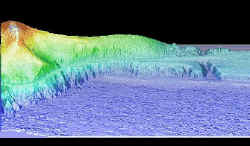Gain without Pain

Blow up a small photo to poster size, and you’re sure to see some graininess in the picture. But it’s not all from the original: the amplification process itself adds some of this “noise” to the image. In fact, almost all methods of amplifying small signals degrade the product to some extent. But the 6 September PRL describes the first “noiseless” amplification of an image, where the output image had essentially the same graininess as the input. The technique may be applicable to situations where faint coherent signals must be amplified, such as in laser radar and in new methods of human tissue imaging.
Noiseless amplification was first proposed in the early 1980s, and by the early 1990s it had been accomplished for time-varying signals. To amplify images–signals that vary in space–Prem Kumar and his colleagues at Northwestern University in Evanston, IL, used a so-called optical parametric amplifier (OPA)–a potassium titanyl phosphate (KTP) crystal that can convert green photons into pairs of infrared (IR) photons. A green “pump” laser aimed at the crystal produces photon pairs whose phases–timing of their oscillating electric fields–are random and anticorrelated: If one photon of the pair is slightly ahead of the pump laser’s phase, the other photon’s phase will be an equal amount behind it. But the average phase of the IR light produced by the crystal matches that of the pump laser.
The OPA can amplify an IR signal because when both an IR (signal) beam and a green (pump) beam hit the crystal simultaneously, the IR beam “stimulates” the production of additional pairs of IR photons from green photons, beyond those that the green beam would create alone. The amplification is analogous to that of a laser, if the unassisted (nonstimulated) pair production is labeled as “spontaneous.” The difference is that the average phase of an OPA’s spontaneous pairs can be controlled, whereas that of a laser’s spontaneously emitted photons cannot.
The Northwestern team sent their IR beam through a double slit pattern which served as the image to be amplified. If their IR signal were uncorrelated with the pump beam, the spontaneous photon pairs would interfere with the stimulated pairs and add to the graininess of the amplified image. But the team synchronized the phases of the IR and green lasers, so that the spontaneous photons (averaged pair-by-pair) were “in phase” with the signal and with the stimulated pairs. Kumar and his colleagues measured the signal-to-noise ratio at several positions in their one-dimensional image both with and without amplification and found it to be essentially constant in space and unchanged by the amplification process.
Kumar explains that the experiment depended critically upon synchronizing the phases of the signal and pump beams, so the technique won’t work on starlight or other incoherent sources. But Kumar says it could be used whenever laser light generates the signal, such as in laser radar, as long as the path length isn’t too long. He also cites a newly developed medical imaging technique that detects the faint signal of modulated laser light that penetrates human tissue.
“It’s a pretty neat experiment,” says Carlton Caves of the University of New Mexico in Albuquerque. He says “squeezed light” applications–of which noiseless amplification is one example–have not lived up to the excitement they generated in the 1980s because they were impractical for many time-varying signals. But image amplification is “a new direction” for squeezed light “that looks to be a better deal,” he says.
More Information
Recent related paper: Phys. Rev. Lett. 83, 1763 (1999)


